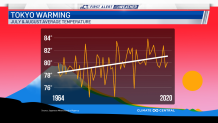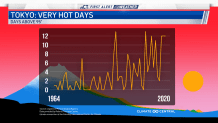Rising temperatures could impact the health and performance of Olympians competing in Tokyo.
Tokyo already has a hot and humid summertime climate. And with exceptional heat expected over the next few weeks, the Tokyo Olympics may take the gold for the hottest summer games in modern times.
This data provided by Climate Central shows that in Tokyo, the July and August average temperatures has warmed by 2.7 degrees Fahrenheit since the last time the Olympics were held there in 1964.

Get Connecticut local news, weather forecasts and entertainment stories to your inbox. Sign up for NBC Connecticut newsletters.
And right here in Connecticut, the Korey Stringer Institute at UConn helped prepare the U.S. Womens’ soccer team for the hot weather in Tokyo.
“It’s very different from what the U.S. Women’s soccer team is used to,” explains Margaret Morrissey, director of occupational safety at the Korey Stringer Institute.
The Korey Stringer Institute is a nonprofit in Storrs dedicated to preventing sudden death in sports, with a focus on exertional heatstroke, one of several heat-related illnesses top of mind at the summer games. So before leaving for Tokyo, the U.S. Women’s soccer team trained with KSI.
“We prepared them for Tokyo by performing repeated heat exposures in order for them to obtain the physiological adaptations that will benefit their performance as well as safety in the heat when they’re over in Tokyo,” says Morrissey. “They’ll have lower core temperatures, heart rates, better onset of sweating to cool the body to keep them safe and also perform better when they’re over there.”
The average high temperature between July and August in Tokyo is 86.5 degrees…and over the next several days temperatures are forecast to be in the 90s.
While heatstroke is the biggest concern for athletes, other heat-related illnesses Olympic officials will be looking out for include heat exhaustion, which is most common, heat cramps and heat syncope, also known as heat fainting.
And the rising temperatures as a result of climate change in Tokyo is really very similar to what we’re seeing locally. Since temperatures started being recorded in the late 1800s in Connecticut, our temperatures have increased by three degrees Fahrenheit on average.
“But that average temperature trend increases translates to a faster increase in extreme temperatures and nighttime temperatures,” explains Anji Seth, a climatologist and professor at the University of Connecticut. “So there’s a very clear increase in the frequency of say, days above 90 degrees, or days above 100 degrees”
We experienced that in June with two heat waves totaling nine days above 90 degrees. And that’s exactly what they’re seeing in Tokyo, too. And that’s exactly what they’re seeing in Tokyo, too.

Since the last summer games in 1964, the number of days above 95 degrees has increased by eight days and last summer between July and August there were 12 days above 95 degrees.
Don’t miss the most exciting moments of the Winter Olympics in Beijing! Sign up for our Olympics newsletter.



